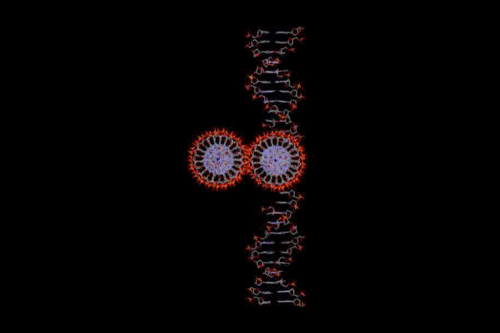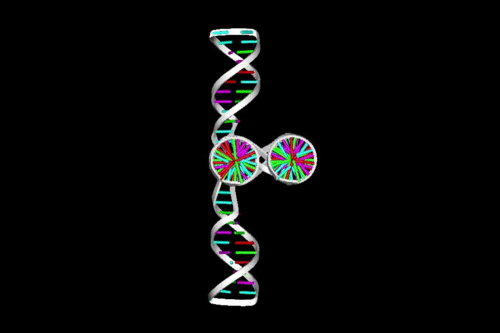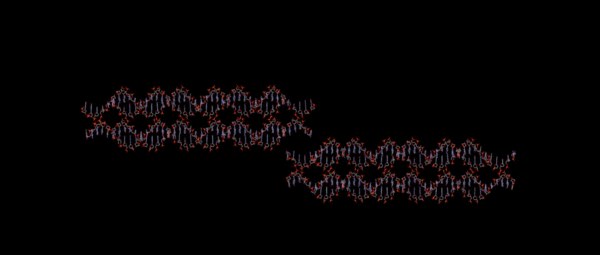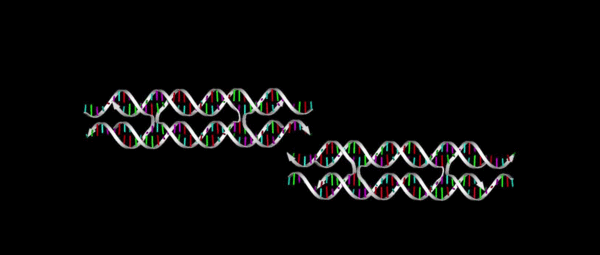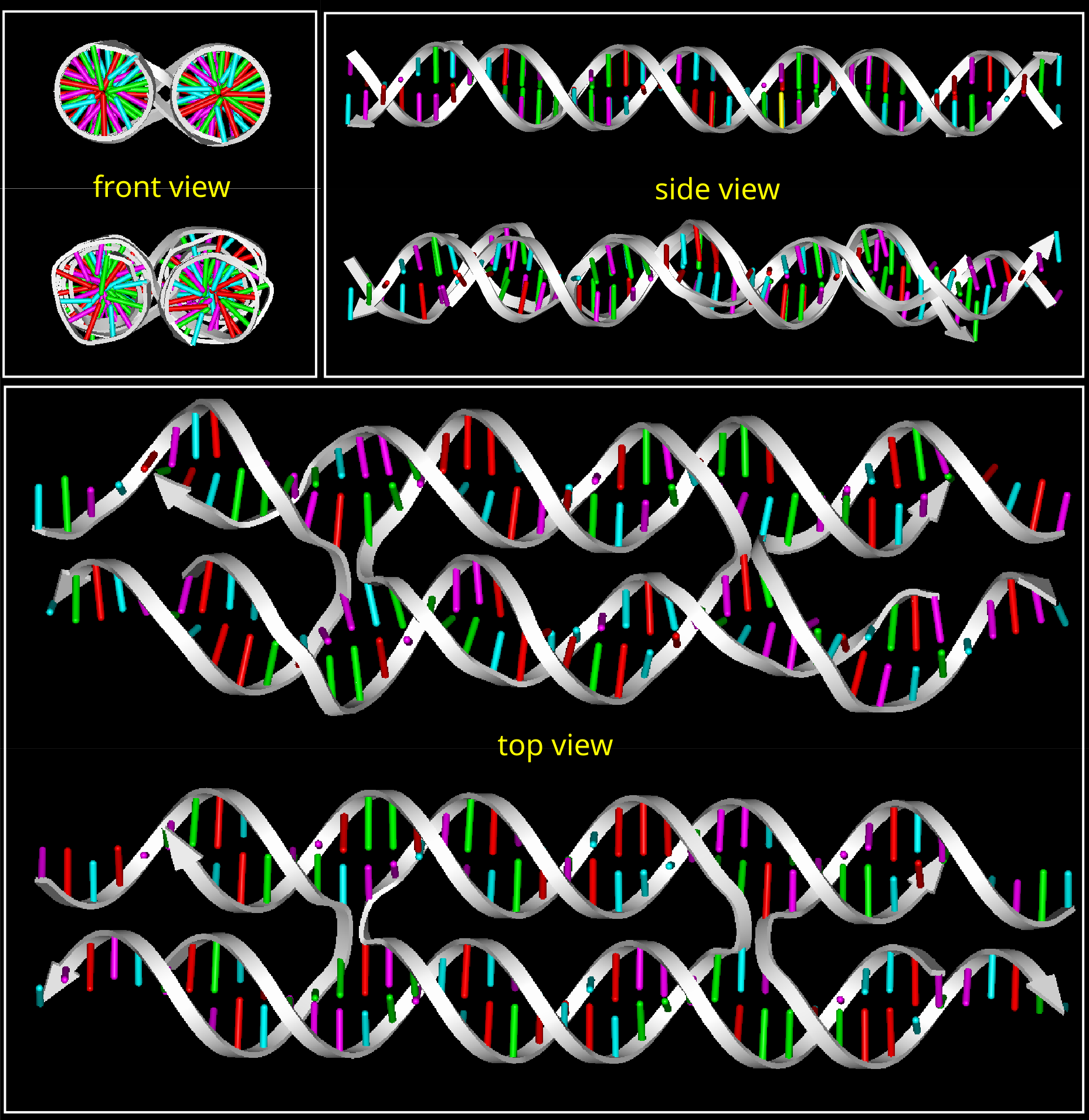Want to create your own atomically correct double-crossover tiles? Keep reading!
DXseq is a program which reads in a DNA nucleotide sequence and outputs the spatial coordinates of each atom of each nucleotide comprising that sequence in a Protein Data Bank (PDB) format. Currently, the nucleotides are stacked in B-form (other DNA conformations may be added in the future). Once the output file is produced, it can be used for molecular dynamic studies or molecular visualization software can be used to visualize the tertiary structure of the DNA.
Although the atomic coordinates of any DNA structure can be produced using this program, at present the only available command-line options are for various types of DX tiles (hence the name, DXseq).
DXseq is written in Python 2.7. In order to run the program you must have Python installed on your computer. This software has not been tested with Python 3.0 or higher, so I cannot guarantee it will work under those environments. If you do not have Python installed on your computer, you may download the latest version at http://www.python.org/download/.
All python package dependencies can be installed using pip. pip does not
come pre-installed with the python virtual machine, so you need to install
it manually.
-
Install
python-pip, if you do not have it installed (the package name may bepython2-pip, since you need python 2.7). -
Upgrade
pip.$ sudo pip install pip --upgrade -
Install all required dependencies by typing
$ pip install -r requirements.txt
Presently, you just need numpy (something near version 1.10.1) installed.
At the command-line prompt, type the following (you may need to replace
python2 with python depending on your system setup; this program is
written in python 2.7)
$ python2 DXseq.py -h
usage: DXseq.py [-h] [-o {OO,OX,XO,XX}] [-c] {CR,STL,DTL,MDX}
produces PDB files of different types of DX tiles with/without hairpins
positional arguments:
{CR,STL,DTL,MDX} choose between CR, STL, DTL, and MDX tile types.
CR : a single CR-type DX tile
STL : two DX tiles
DTL : three DX tiles
MDX : two connected regular DX tiles
optional arguments:
-h, --help show this help message and exit
-o {OO,OX,XO,XX}, --options {OO,OX,XO,XX}
OO : complementarity & geometric compatibility (default)
OX : complementarity & geometric incompatibility
XO : noncomplementarity & geometric compatibility
XX : noncomplementarity & geometric incompatibility
-c, --curvature use experimental X-ray data for each nucleotide position
instead of idealized values
To create a PDB file of a normal CR-type DX tile,
$ python2 DXseq.py CR
which produces a CR.pdb text file looking something like the following:
ATOM 1 P T a 1 7.306 2.606 -2.062 1.00 0.00 P
ATOM 2 O1P T a 1 7.322 3.921 -2.742 1.00 0.00 O
ATOM 3 O2P T a 1 8.196 2.472 -0.887 1.00 0.00 O
ATOM 4 O5* T a 1 5.807 2.236 -1.644 1.00 0.00 O
ATOM 5 C5* T a 1 4.956 1.579 -2.604 1.00 0.00 C
ATOM 6 C4* T a 1 4.190 0.455 -1.937 1.00 0.00 C
ATOM 7 O4* T a 1 4.925 -0.802 -1.951 1.00 0.00 O
...
Here are what some of the numbers above mean (taking the first row as an example):
The ATOM in the first column identifies the particle type, the 1 in the
second column is the atom number, the P in the third column is the atom
type, the T in the fourth column is the base type, the a in the fifth
column is the strand number, the 1 in the sixth column is the base number,
and the following three numbers, 7.306 2.606 -2.062, are the xyz spatial
coordinates.
Use your favorite molecular viewing program to create a 3D rendering of this file.
PDBs of multiple DX tiles can be produced simultaneously using STL, DTL,
and MDX commands. For instance a rendering of the PDB file produced by the
command
$ python2 DXseq.py STL -o OO
using the ViewerLite program is shown below.
The positional arguments STL and DTL along with the optional arguments
-o {OO, OX, XO, XX} produce various configurations of dimer DX tiles which
we used in this ACS Nano paper.
Another feature this program offers is the calculation of the intrinsic
curvature of DNA due to its flexibility. When this is turned on (via the -c
flag on the command-line), the structural parameters of the DNA (i.e., twist,
roll, tilt, and slide) changes from idealized values to
values calculated from 36 independent tetramers
based on experimental values from the
Nucleic Acid Database.
The differences between the two can be seen below.
We used this model to study the relationship between DX crystal sizes and the structural distortion arising from the flexibility of the DX tiles in this Nanotechnology paper.
Thanks to Seungjae Kim for sharing his version of the code.
